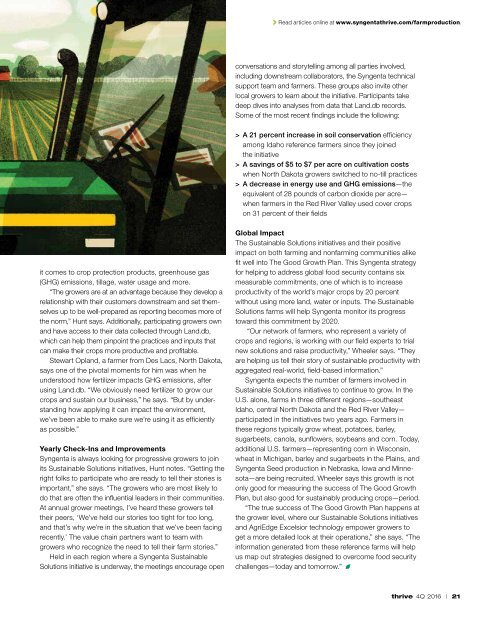thrive
current-issue
current-issue
You also want an ePaper? Increase the reach of your titles
YUMPU automatically turns print PDFs into web optimized ePapers that Google loves.
Read articles online at www.syngenta<strong>thrive</strong>.com/farmproduction.<br />
conversations and storytelling among all parties involved,<br />
including downstream collaborators, the Syngenta technical<br />
support team and farmers. These groups also invite other<br />
local growers to learn about the initiative. Participants take<br />
deep dives into analyses from data that Land.db records.<br />
Some of the most recent findings include the following:<br />
> A 21 percent increase in soil conservation efficiency<br />
among Idaho reference farmers since they joined<br />
the initiative<br />
> A savings of $5 to $7 per acre on cultivation costs<br />
when North Dakota growers switched to no-till practices<br />
> A decrease in energy use and GHG emissions—the<br />
equivalent of 28 pounds of carbon dioxide per acre—<br />
when farmers in the Red River Valley used cover crops<br />
on 31 percent of their fields<br />
it comes to crop protection products, greenhouse gas<br />
(GHG) emissions, tillage, water usage and more.<br />
“The growers are at an advantage because they develop a<br />
relationship with their customers downstream and set themselves<br />
up to be well-prepared as reporting becomes more of<br />
the norm,” Hunt says. Additionally, participating growers own<br />
and have access to their data collected through Land.db,<br />
which can help them pinpoint the practices and inputs that<br />
can make their crops more productive and profitable.<br />
Stewart Opland, a farmer from Des Lacs, North Dakota,<br />
says one of the pivotal moments for him was when he<br />
understood how fertilizer impacts GHG emissions, after<br />
using Land.db. “We obviously need fertilizer to grow our<br />
crops and sustain our business,” he says. “But by understanding<br />
how applying it can impact the environment,<br />
we’ve been able to make sure we’re using it as efficiently<br />
as possible.”<br />
Yearly Check-Ins and Improvements<br />
Syngenta is always looking for progressive growers to join<br />
its Sustainable Solutions initiatives, Hunt notes. “Getting the<br />
right folks to participate who are ready to tell their stories is<br />
important,” she says. “The growers who are most likely to<br />
do that are often the influential leaders in their communities.<br />
At annual grower meetings, I’ve heard these growers tell<br />
their peers, ‘We’ve held our stories too tight for too long,<br />
and that’s why we’re in the situation that we’ve been facing<br />
recently.’ The value chain partners want to team with<br />
growers who recognize the need to tell their farm stories.”<br />
Held in each region where a Syngenta Sustainable<br />
Solutions initiative is underway, the meetings encourage open<br />
Global Impact<br />
The Sustainable Solutions initiatives and their positive<br />
impact on both farming and nonfarming communities alike<br />
fit well into The Good Growth Plan. This Syngenta strategy<br />
for helping to address global food security contains six<br />
measurable commitments, one of which is to increase<br />
productivity of the world’s major crops by 20 percent<br />
without using more land, water or inputs. The Sustainable<br />
Solutions farms will help Syngenta monitor its progress<br />
toward this commitment by 2020.<br />
“Our network of farmers, who represent a variety of<br />
crops and regions, is working with our field experts to trial<br />
new solutions and raise productivity,” Wheeler says. “They<br />
are helping us tell their story of sustainable productivity with<br />
aggregated real-world, field-based information.”<br />
Syngenta expects the number of farmers involved in<br />
Sustainable Solutions initiatives to continue to grow. In the<br />
U.S. alone, farms in three different regions—southeast<br />
Idaho, central North Dakota and the Red River Valley—<br />
participated in the initiatives two years ago. Farmers in<br />
these regions typically grow wheat, potatoes, barley,<br />
sugarbeets, canola, sunflowers, soybeans and corn. Today,<br />
additional U.S. farmers—representing corn in Wisconsin,<br />
wheat in Michigan, barley and sugarbeets in the Plains, and<br />
Syngenta Seed production in Nebraska, Iowa and Minnesota—are<br />
being recruited. Wheeler says this growth is not<br />
only good for measuring the success of The Good Growth<br />
Plan, but also good for sustainably producing crops—period.<br />
“The true success of The Good Growth Plan happens at<br />
the grower level, where our Sustainable Solutions initiatives<br />
and AgriEdge Excelsior technology empower growers to<br />
get a more detailed look at their operations,” she says. “The<br />
information generated from these reference farms will help<br />
us map out strategies designed to overcome food security<br />
challenges—today and tomorrow.”<br />
<strong>thrive</strong> 4Q 2016 | 21


